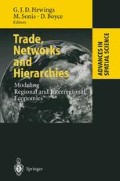Abstract
The U.S. regional ferrous scrap model developed at the University of Pittsburgh is capable of simulating price interactions at a significant degree of geographic detail. In this model, estimates of the supply and demand for ferrous scrap in hundreds of local markets are used to estimate a set of equilibrium prices. The model can be used to simulate the impact of market changes such as new plant locations or transport rate adjustments on regional scrap prices. The analysis involved is based on realistic modeling of regional price interactions as well as careful attention to metallurgical relationships. The capability of the model provides a linkage between basic supply and demand conditions and an extensive network of regional scrap prices. Modeling simulations can be used to map price gradients across the United States based on very small county-based regions, providing useful information on spatial price differences.
This research is supported by the Alfred P. Sloan Foundation through the Alfred P. Sloan Steel Industry Center (http://steel.ucsur.pitt.edu/steel/index.htm), which is organized jointly by faculty members at the University of Pittsburgh and Carnegie Mellon University. Craig Richmond developed the prototype for this model as his doctoral dissertation at the University of Pittsburgh. Dilek Aykut, Carey Treado and Yulonda Woods have served as graduate student research assistants on this project.
Access this chapter
Tax calculation will be finalised at checkout
Purchases are for personal use only
Preview
Unable to display preview. Download preview PDF.
References
Ahlbrandt, R.S., R. Fruehan and F. Giarratani. 1996. The Renaissance of American Steel. Oxford University Press, Oxford.
American Iron and Steel Institute (Various years). Annual Statistical Report, American Iron and Steel Institute, Washington DC:
American Metal Market (Various issues). American Metal Market, New York...
Anderson, S. and A. de Palma. 1992a. “The Logit as a Model of Product Differentiation. Oxford Economic Papers, 44, 51–67.
Anderson, S. and A. de Palma. 1992b. Discrete choice theory of product differentiation. Cambridge, Massachusetts Institute of Technology Press.
Carload Waybill Statistics. 1989. U.S. Department of Transportation, Federal Railway Administration. Washington, Government Printing Office.
County Business Patterns. Various years. U.S. Department of Commerce, Bureau of the Census. CD ROM and computer tape. Washington: Administrative and Customer Services Division.
d’Aspremont C., J.J. Gabszewitz, and J-F. Thisse. 1979. “On Hotelling’s Stability in Competition.” Econometrica, 17, 1145–1151.
de Palma, A., V. Ginsburgh, Y.Y. Papagiorgiou, and J-F. Thisse. 1985. “The Principle of Minimum Differentiation Holds under Sufficient Heterogeneity.” Econometrica, 53, 767–781.
de Palma, A., R. Lindsey, B. von Hohenbalken and D.S. West. 1994. “Spatial price and variety competition in an urban retail market, A nested logit analysis.” International Journal of Industrial Organization, 12, 331–357.
Greenhut, M.L., G. Norman, and C-S. Hung. 1987. The Economics of Imperfect Competition A Spatial Approach. Cambridge University Press, Cambridge.
Hotelling, H. 1929. “Stability in Competition.” Economic Journal, 39, 41–57.
Iron Age: New Steel. (Various issues). Cahners Business Information, Oak Brook, Il
James W. Brown Associates. 1994. U.S. Mini-Mill Feedstock Availability, Quality, and Cost Through the Year 2000. New York: Chilton Publications.
Marley, M. 2000a. “Aluminum.com will unveil global online marketplace at ISRI.” American Metal Market, 108, No. 49, 1.
Marley, M. 2000b. “Scrap execs differ on e-commerce.” American Metal Market, 108, No. 51, 1.
Marley, M. 2000c. “US ferrous Exports, Role as ‘world’s largest scrap yard’ changing.” American Metal Market, Special Report: Metals Recycling, March 14, 2000, p. 2a.
Regional Economic Information System. (Various years). CD ROM, U.S. Department of Commerce, Bureau of the Economic Analysis. Washington: Administrative and Customer Services Division.
Richmond, C. 1997. “Simulating differences in ferrous scrap prices over geographic space using the logistic model of choice for differentiated products.” Unpublished doctoral dissertation, University of Pittsburgh.
Sheppard E., R. Haining, and P. Plummer. 1992. “Spatial Pricing in Interdependent Markets.” Journal of Regional Science, 32, 55–75.
Whipp, R. 1993. “A spreadsheet model for Optimizing the Scrap Mix in Electric Furnace Shops.” Iron and Steel Maker, July, 31–34.
Worden, E. 2000. “Metal Site, other interests preparing to start up new Internet site.” American Metal Market, 108, No. 49, 1.
Author information
Authors and Affiliations
Editor information
Editors and Affiliations
Rights and permissions
Copyright information
© 2002 Springer-Verlag Berlin Heidelberg
About this chapter
Cite this chapter
Giarratani, F., Gruver, G., Richmond, C. (2002). The US Regional Ferrous Scrap Model. In: Hewings, G.J.D., Sonis, M., Boyce, D. (eds) Trade, Networks and Hierarchies. Advances in Spatial Science. Springer, Berlin, Heidelberg. https://doi.org/10.1007/978-3-662-04786-6_9
Download citation
DOI: https://doi.org/10.1007/978-3-662-04786-6_9
Publisher Name: Springer, Berlin, Heidelberg
Print ISBN: 978-3-642-07712-8
Online ISBN: 978-3-662-04786-6
eBook Packages: Springer Book Archive

